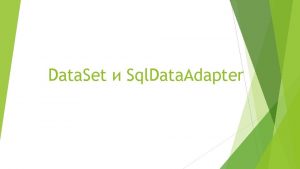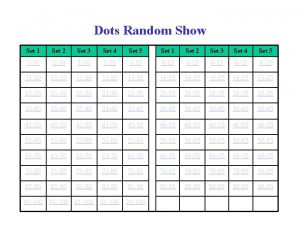The Data Set Data Set As part of







































- Slides: 39

The Data Set

Data Set • As part of the Statistics element of the course • You will be required to familiarise yourself with a large data set • Whilst you will not be required to know all of it you will be manipulating the data throughout your course • Tools BYOD • Calculator in addition to your calculator we would advise purchasing a more advanced one

Casio fx 991 ex classwiz

data set this is also saved on firefly under A Level/summer work/ bridging • To support the use of the large data set in the teaching of the statistics content, tasks such as: ● selecting a sample ● cleaning the data ● creating diagrams from the data ● calculating summary statistics such as mean, standard deviation ● calculating regression equations and correlation coefficients where applicable ● hypothesis testing, must be carried out by students during their course of study. Students should use technology such as spreadsheets or other statistical packages to explore the data.

Section 1 the weather stations Can you locate the 5 weather stations on the map

Can you identify where the 3 overseas locations are


Section 3 Which stations are: • Coastal? • Inland? • Overseas? • Most southern? • Most northern? • Northern hemisphere? • Southern hemisphere? • Which have the highest/lowest altitude?

What are the 11 variables?


The data set • What does the large data set show? • Which two periods of time are included in the data set? • Did anything significant happen weather wise in either of the 2 time periods?

• Is there any thing significant weather wise you should be aware of for the overseas stations?

Is there any thing significant weather wise you should be aware of for the overseas stations? La Niña - National Geographic Society

La Niña • La Niña is a climate pattern that describes the cooling of surface ocean waters along the tropical west coast of South America. La Nina is considered to be the counterpart to El Nino, which is characterized by unusually warm ocean temperatures in the equatorial region of the Pacific Ocean. • • Together, La Niña and El Niño are the "cold" (La Niña) and "warm" (El Niño) phases of the El Nino-Southern Oscillation (ENSO). ENSO is series of linked weather- and ocean-related phenomena. Besides unusually warm or cool sea-surface temperatures, ENSO is also characterized by changes in atmospheric pressure.

La Niña • La Niña is caused by a build-up of cooler-than-normal waters in the tropical Pacific, the area of the Pacific Ocean between the Tropic of Cancer and the Tropic of Capricorn. Unusually strong, eastwardmoving trade winds and ocean currents bring this cold water to the surface, a process known as upwelling. • • Upwelling can cause a drastic drop in sea-surface temperature. Coastal sea-surface temperatures near Ecuador and Peru dropped nearly 4 degrees Celsius (7 degrees Fahrenheit) during the 1988 -89 La Niña event.



El Niño • As El Niño brings rain to South America, it brings droughts to Indonesia and Australia. These droughts threaten the region’s water supplies, as reservoirs dry and rivers carry less water. Agriculture, which depends on water for irrigation, is threatened. • • Stronger El Niño events also disrupt global atmospheric circulation. Global atmospheric circulation is the large-scale movement of air that helps distribute thermal energy (heat) across the surface of the Earth. The eastward movement of oceanic and atmospheric heat sources cause unusually severe winter weather at the higher latitudes of North and South America. Regions as far north as the U. S. states of California and Washington may experience longer, colder winters because of El Niño.

El Niño • El Niño is characterized by unusually warm ocean temperatures in the Equatorial Pacific, as opposed to La Niña, which is characterized by unusually cold ocean temperatures in the Equatorial Pacific. El Niño is an oscillation of the ocean-atmosphere system in the tropical Pacific having important consequences for weather around the globe. • Among these consequences are increased rainfall across the southern tier of the US and in Peru, which has caused destructive flooding, and drought in the West Pacific, sometimes associated with devastating brush fires in Australia. Observations of conditions in the tropical Pacific are considered essential for the prediction of short term (a few months to 1 year) climate variations.

Section 4 Measurement • What is the Beaufort scale and what does it measure? • How do you measure cloud cover ? • What unit of measurement is used for cloud cover? • What is a knot? • What is measured in knots?

Section 4 Measurement • How do you measure a gust of wind? • How do your measure daily mean pressure? • What is daily maximum relative humidity? What is cardinal direction? • How is visibility measured? • If something is recorded as Tr what does this mean?

Section 5 -Find definitions for the following • Population • Sample • Census • Sampling unit • Sampling

example Simple random sampling Systematic Stratified Quota Opportunity/ convenience advantage disadvantage







Section 7 What is meant by: • Qualitative data • Quantitative data • Discrete data • Continuous data • Class boundary • Class width • Midpoint









 What is the overlap of data set 1 and data set 2?
What is the overlap of data set 1 and data set 2? Total set awareness set consideration set
Total set awareness set consideration set Training set validation set test set
Training set validation set test set Hát kết hợp bộ gõ cơ thể
Hát kết hợp bộ gõ cơ thể Ng-html
Ng-html Bổ thể
Bổ thể Tỉ lệ cơ thể trẻ em
Tỉ lệ cơ thể trẻ em Chó sói
Chó sói Tư thế worm breton là gì
Tư thế worm breton là gì Hát lên người ơi alleluia
Hát lên người ơi alleluia Các môn thể thao bắt đầu bằng từ đua
Các môn thể thao bắt đầu bằng từ đua Thế nào là hệ số cao nhất
Thế nào là hệ số cao nhất Các châu lục và đại dương trên thế giới
Các châu lục và đại dương trên thế giới Công thức tiính động năng
Công thức tiính động năng Trời xanh đây là của chúng ta thể thơ
Trời xanh đây là của chúng ta thể thơ Mật thư anh em như thể tay chân
Mật thư anh em như thể tay chân Làm thế nào để 102-1=99
Làm thế nào để 102-1=99 Phản ứng thế ankan
Phản ứng thế ankan Các châu lục và đại dương trên thế giới
Các châu lục và đại dương trên thế giới Thơ thất ngôn tứ tuyệt đường luật
Thơ thất ngôn tứ tuyệt đường luật Quá trình desamine hóa có thể tạo ra
Quá trình desamine hóa có thể tạo ra Một số thể thơ truyền thống
Một số thể thơ truyền thống Cái miệng nó xinh thế
Cái miệng nó xinh thế Vẽ hình chiếu vuông góc của vật thể sau
Vẽ hình chiếu vuông góc của vật thể sau Thế nào là sự mỏi cơ
Thế nào là sự mỏi cơ đặc điểm cơ thể của người tối cổ
đặc điểm cơ thể của người tối cổ V. c c
V. c c Vẽ hình chiếu đứng bằng cạnh của vật thể
Vẽ hình chiếu đứng bằng cạnh của vật thể Vẽ hình chiếu vuông góc của vật thể sau
Vẽ hình chiếu vuông góc của vật thể sau Thẻ vin
Thẻ vin đại từ thay thế
đại từ thay thế điện thế nghỉ
điện thế nghỉ Tư thế ngồi viết
Tư thế ngồi viết Diễn thế sinh thái là
Diễn thế sinh thái là Dot
Dot Số.nguyên tố
Số.nguyên tố Tư thế ngồi viết
Tư thế ngồi viết Lời thề hippocrates
Lời thề hippocrates Thiếu nhi thế giới liên hoan
Thiếu nhi thế giới liên hoan ưu thế lai là gì
ưu thế lai là gì































































